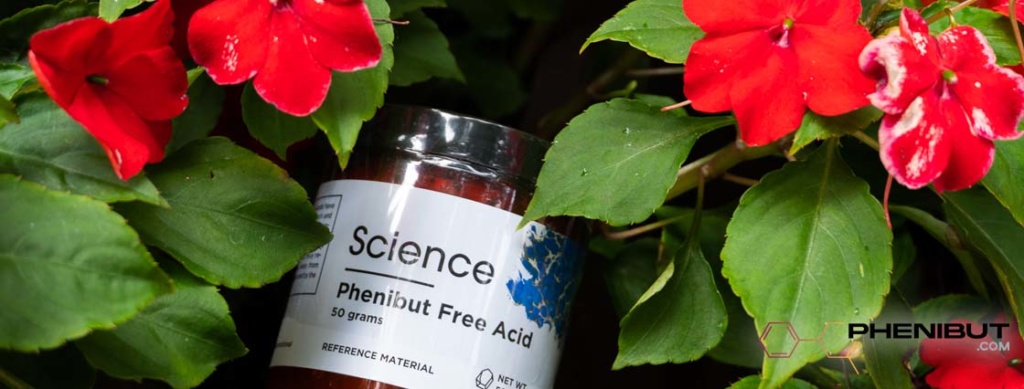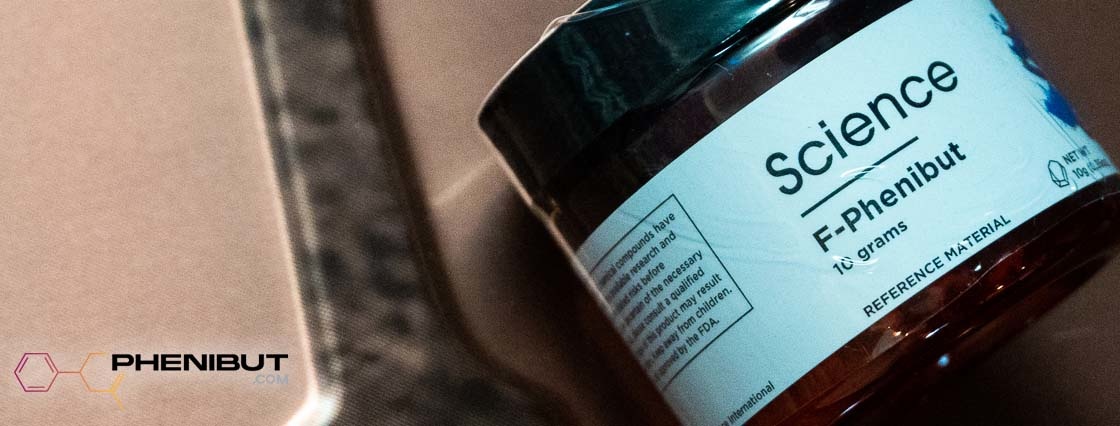Can you get “high” on phenibut?
Nootropic researchers are interested in understanding whether ingesting phenibut can result in a “high” that leads to altered behavior in human subjects.
In this guide, we’ll provide some background on the commonly reported effects of phenibut, the extent to which phenibut can lead to a euphoric or “high” feeling, phenibut half-life, and more.
Order Phenibut online from the best vendor in the world!
Great prices, quick shipping, and guaranteed delivery.
Disclaimer: Phenibut.com contains information about products that are intended for laboratory and research use only, unless otherwise explicitly stated. This information, including any referenced scientific or clinical research, is made available for educational purposes only. Phenibut.com makes every effort to ensure that any information it shares complies with national and international standards for clinical trial information and is committed to the timely disclosure of the design and results of all interventional clinical studies for innovative treatments publicly available or that may be made available. However, research is not considered conclusive. Phenibut.com makes no claims that any products referenced can cure, treat or prevent any conditions, including any conditions referenced on its website or in print materials.
What Is Phenibut?
Before delving into how phenibut can cause a “high-like” experience in test subjects, it’s worth understanding what phenibut is and how it works.
Phenibut, also called β‐phenyl‐γ‐aminobutyric acid, is a chain of amino acids [1]. The chain looks chemically similar to a key neurotransmitter that helps our brain send and receive signals through our nerves: gamma-aminobutyric acid or GABA [2].
GABA’s job is to inhibit excitability in the nervous system. It tells the nerves to stop firing off messages. This is useful because a person’s nerves shouldn’t always be firing— they need to take a break every once in a while. Phenibut works like GABA—it binds to the same receptors and reduces the amount of brain activity.
Because it works on the same receptors as GABA, phenibut has similar effects: it causes the nerve cells to relax and recover.
Phenibut is also responsible for upregulating dopamine and serotonin [3]. Dopamine and serotonin are both neurochemicals and are implicated in mood regulation. They make people feel good. Dopamine especially is often considered a part of the brain’s “reward center.”
Phenibut effects
In brief, phenibut increases GABA activity and upregulates serotonin and dopamine levels. The effect? Some studies have found that phenibut, in some circumstances and in some subjects, can:
- Reduce anxiety. This has been found in a small sample of patients with chronic cerebral ischemia [4];
- Reduce symptoms associated with depression. This has been found in a small sample of patients with heroin addiction [5];
- Reduce anxiety and phobia symptoms. This has been found in a small sample of patients with anxiety-phobic disorders [6];
- Improve sleep. This has been found in a small sample of patients with chronic cerebral ischemia that had disordered sleep [4].
Note that there is limited research on phenibut and almost all existing research has significant methodological limitations, including low sample sizes. Still, the existing research has been used to justify the approval of phenibut as a medication to reduce anxiety and treat insomnia in some countries [1, 7].
In the United States, phenibut is classified as a “New Drug” under the Federal Food, Drug, and Cosmetic Act (FD&C Act). It has not been investigated or approved for use beyond research.

Phenibut Side Effects and Safety
We’ve detailed the science on phenibut side effects in a separate article, so will only briefly touch on the topic here. The take-away is that all nootropic researchers should understand that there are significant risks to phenibut ingestion, so let’s go over the main side effects and safety considerations.
Potential phenibut side effects fall into three main categories: (i) actual side effects and allergic reactions; (ii) interaction effects, which occur when phenibut is mixed with another substance like alcohol; (iii) and withdrawal effects, which occur if an individual develops a physical dependence on phenibut.
Side Effects
The research literature suggests that adverse effects from phenibut, at prudent dosages, are uncommon. Some reported side effects of phenibut are [7, 8, 9, 10] [9 in Russian]:
- Drowsiness
- Nausea
- Irritability
- Headache
- Sedation
More rarely, individuals have also reported more specific side effects like [7, 9]:
- Motor incoordination
- Hangover-like symptoms
- Loss of balance
Allergies are also possible, and phenibut exposure may lead to itchiness or rashes.
Note that, among exposures in which phenibut was the only drug or agent involved, there has been at least one death reported to a U.S. poison center. We are not aware of the exact circumstances of that death [11].
Want to mitigate the occurrence and severity of phenibut side effects? Ensure that the dose used in your research is appropriate and not too high. Consider creating a flexible dosing protocol where participants start with a low phenibut dosage to see how their body reacts, before deciding whether to increase their dose. Such a dosing strategy may reduce the risk of your human participants experiencing side effects.
Interaction Effects
These are the effects that happen when phenibut is mixed with other substances. Since phenibut works on the GABA receptors and reduces excitability in your body, it should not be mixed with other substances that have similar effects. That means your research protocol should discourage participants to take phenibut if they are also taking [1, 12]:
- benzodiazepines
- anticonvulsant medications
- antipsychotic medications
- barbiturates
- alcohol
If your participants mix phenibut with these, they may experience exaggerated effects of either or both substances. That could be dangerous, especially if they’re taking high doses of either. The interaction of the substances could cause:
- Severe drowsiness
- Nausea
- Vomiting
- Lowered blood pressure
- Impairment of the kidneys
- Delirium or psychosis [13, 14]
Dependence and Withdrawal
Phenibut use can lead to addiction, dependence, and withdrawal [14, 15]. There are few statistics on the proportion of phenibut users that develop dependence or withdrawal, so it’s difficult to characterize how common it is. But the research literature does consistently caution that addiction and dependence are important risk factors with phenibut [14, 15].
How can you minimize the risk that your research subjects develop a phenibut dependence? These are some general precautions one can take to minimize the risk of phenibut dependence.
- Use low doses. Research studies on phenibut have used doses of 1 gram a day [6]. Consider developing a protocol that uses that dosing level or less.
- Don’t require participants to take it often. Consider developing your research study such that participants use phenibut 1 to 2 times a week at most.
- Cycling. Develop your protocol such that participants take time off of using phenibut.
Phenibut High | The Basics
Now, let’s go over what some reports have characterized as a “phenibut high.”
Before we can determine whether the effects of phenibut can be described as a “high,” we must define what we mean by “high.” Science is a bit behind in terms of providing a definition for being “high” with respect to substances.
But for purposes of this article, let’s define a “high” as an alteration in mood and a feeling of euphoria.
By that definition, there does appear to be some evidence that phenibut can lead to a “high” feeling, although it’s quite different from the effects of other substances like alcohol.
A person who has taken phenibut, for example, will generally not feel the lack of coordination or slurring of speech that is common with alcohol, nor will they experience hallucinations as they might on other drugs.
But phenibut can alter a human subject’s emotional state and lead to a sense of euphoria.

Does Phenibut Get You High?
Yes, the effects of phenibut can be described as a kind of “high,” even if it isn’t at all like the effects of common recreational drugs.
Here’s what your subjects can expect in terms of possible effects from phenibut use.
Euphoria
At first, subjects may notice a feeling of euphoria. This may be a result of the upregulation of dopamine. It could be a bit like the buzz from alcohol, but without the brain fog. They may notice relief from anxiety [8].
This feeling could be described as similar to the feeling one gets after working out, without the exhaustion.
More social
Participants may also feel more social [8]. Subjects have reported that phenibut helps them deal with social anxiety. They may feel less anxious about talking to strangers.
Clear-headed
While there’s a clear change in how participants feel, they usually don’t lose mental clarity. They can talk normally and think clearly, their vision isn’t impaired, and they can reason. Phenibut use does not typically lead to the mobility or balance issues that alcohol can cause
Long-lasting
The phenibut high can start anywhere from the first 30 minutes after ingestion and it may build for a few hours.
The half-life is how long it takes for half of a phenibut dose to be eliminated from the body. It’s about five hours [7], so that means if a person takes 500 mg, five hours later there will still be about 250 mg in that person’s bloodstream.
The “high” experience seems to last around three or four hours, and the after-effects of phenibut may last up to 24 hours after that.
Is there a phenibut hangover?
Some test subjects may experience hangover-like effects. People with anxiety may notice a return of their anxiety. Others have reported feeling a bit of a headache or a foggy brain.
After the effects of phenibut have worn off, subjects may feel some negative emotions start to come back. You may support your test subjects by guiding them not to cope with those emotions by taking more phenibut. If they do, they could be increasing the risk of developing a dependence.
How Much Phenibut To Get High?
What dosage of phenibut can create the effects that one might describe as a “phenibut high?”
The effects of a given phenibut dosage will, of course, depend on the particular chemistry of the test subject. We’ve created a phenibut dosage guide that provides more detail on this, but the following is a dosage level that is lower than that used in phenibut research [6]:
- 250mg to 500mg — a starting dose that participants may feel, but may not give a “high.”
- 500mg to 750mg — a dose that may be enough for a participant to feel a “high.”
Phenibut Tolerance
Tolerance to phenibut can be built up fairly quickly. Tolerance is where the body gets used to the effects of phenibut, so what might cause a person to get high one day might not have much of an effect the next.
Ensure that research participants do not take more phenibut than directed. Where phenibut is sold as a medication, manufacturers warn that no more than 2.5 g of phenibut should be used in any single day and no more than 750 mg should be taken at any one time [9].
Phenibut Dosage Guide
Here are some phenibut dosage protocols that you could use for testing different effects with research participants. Note that these are not necessarily recommended dosing protocols. The appropriate dosing protocol will depend on your research study:
For sleep research
- 500mg to 750mg
- split into 1 to 3 doses
- an hour before food
For anxiety research
- 250mg to 500mg,
- split into 1 to 3 doses,
- an hour before food
For research on sociability
- 500mg to 750mg
- in 1 dose
- an hour before food
- 1-2 hours
Microdosing
- 50mg to 250mg
- in 1 dose
- an hour before food

Where To Buy Phenibut Online | 2022 Guide
Phenibut is only available to researchers online.
Our favorite supplier for phenibut is Science.bio. They’re currently the only company we would recommend. Here’s why:
- Their prices are reasonable.
- They package their products in glass bottles that are UV resistant to minimize degradation.
- Their product is pure. They provide a certificate of analysis on their website so you can see a product’s chemical purity for yourself.
- They have convenient payment options that maintain your privacy.
We’ve tried some other companies but we weren't impressed. Science.bio is the best.
Ready to order Phenibut from the top-rated online vendor?
The Phenibut “High” | Verdict
Does phenibut get people high?
Based on the existing research, phenibut can have an effect that could be described as a “high,” as the compound affects mood and mental state. But that “high” is qualitatively different from the effects of other drugs.
Phenibut appears to be able to create feelings of euphoria and removes stress, but it does not generally cause any drunkenness-type effects or hallucinations, and it does not generally alter the subject’s ability to reason and make prudent decisions.

